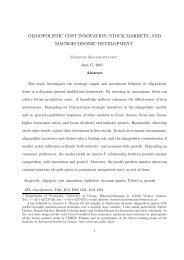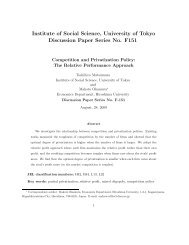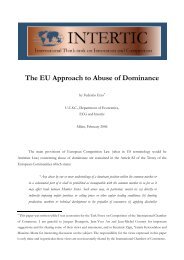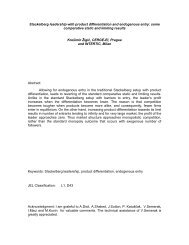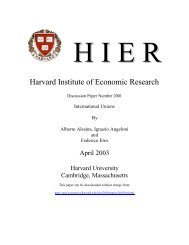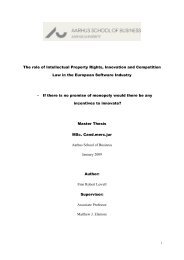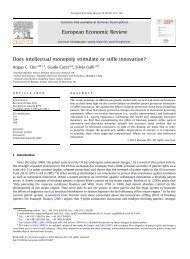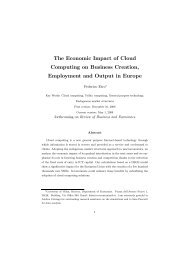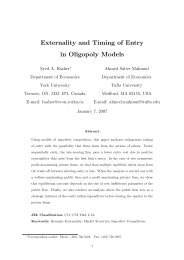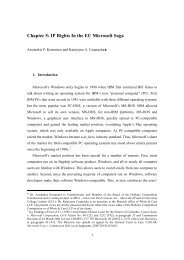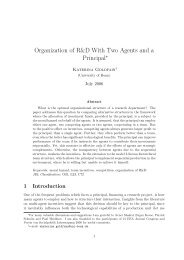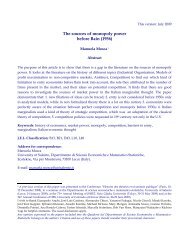Competition, Innovation, and Antitrust. A Theory of Market ... - Intertic
Competition, Innovation, and Antitrust. A Theory of Market ... - Intertic
Competition, Innovation, and Antitrust. A Theory of Market ... - Intertic
You also want an ePaper? Increase the reach of your titles
YUMPU automatically turns print PDFs into web optimized ePapers that Google loves.
1.1 A Simple Model <strong>of</strong> <strong>Competition</strong> in Quantities 7<br />
strategy before the rival, it can use this power to increase pr<strong>of</strong>its excluding<br />
entry. 7 Moreover, if this firm remains alone in the market, it could be able<br />
to restore the monopolistic price in the future. When this is the case, the<br />
exclusionary strategy ends up increasing the final price, therefore antitrust<br />
authorities should punish it as a predatory strategy.<br />
Collusion. A third way to increase pr<strong>of</strong>its requires collusion. To see how<br />
it works in our simple setup, let us go back to the symmetric duopoly. The<br />
reduction in total pr<strong>of</strong>its associated with Cournot competition (compared<br />
to the monopolistic outcome) was due to the fact that each firm did not<br />
take into consideration the impact <strong>of</strong> its own production on the pr<strong>of</strong>its <strong>of</strong><br />
the other firm, <strong>and</strong> hence tended to produce too much from the point <strong>of</strong><br />
view <strong>of</strong> joint pr<strong>of</strong>it maximization. This externality leads to a price reduction<br />
<strong>and</strong> to a decline in total pr<strong>of</strong>its. For this reason the two firms may try to<br />
collude <strong>and</strong> agree on limiting their production at a lower level, possibly at<br />
the monopolistic level. Under perfect collusion, each one <strong>of</strong> the two firms<br />
produces half <strong>of</strong> the monopolistic output, ˜q =(a − c)/4, <strong>and</strong>obtainspr<strong>of</strong>its<br />
˜π =(a − c) 2 /8 − F .<br />
However, only a strong <strong>and</strong> reciprocal commitment could guarantee that<br />
such a collusive behavior is sustainable, because in the absence <strong>of</strong> a commitment<br />
each firm would have incentives to deviate <strong>and</strong> produce more than<br />
that. For instance, if a firm is sure that the other one produces at the collusive<br />
level, this firm can deviate from the collusive strategy <strong>and</strong> choose an<br />
output q D that maximizes π =(a − q D − ˜q)q D − cq D − F .Theoptimaldeviation<br />
is exactly q D =3(a − c)/8. After deviating from the collusive strategy,<br />
this firm increases its pr<strong>of</strong>its to π D =9(a − c) 2 /64 − F , which is above the<br />
collusive pr<strong>of</strong>its, while the pr<strong>of</strong>its <strong>of</strong> the other firm are reduced below them.<br />
This pr<strong>of</strong>itable deviation should not surprise, because there must be always<br />
apr<strong>of</strong>itable deviation for each firm when we are not in the Cournot equilibrium.<br />
Not by chance, we can also provide an alternative definition <strong>of</strong> the<br />
Cournot equilibrium as one in which there are not pr<strong>of</strong>itable deviations for<br />
any firm.<br />
It is important to notice that collusive outcomes can be reached more<br />
easily when interactions are repeated over time, because deviations can be<br />
punished in the future, <strong>and</strong> the threat <strong>of</strong> punishments can reduce the incentives<br />
to deviate. The theory <strong>of</strong> collusion has studied the conditions under<br />
which monopolistic pr<strong>of</strong>its can be sustained in dynamic games. For instance,<br />
if the same competition is repeated infinite times, each firm discounts the<br />
future, <strong>and</strong> each deviation is punished with reversion to the Cournot equilibrium<br />
forever, collusion is sustainable if <strong>and</strong> only if firms are patient enough.<br />
7 Notice, however, that the exclusionary strategy does not necessarily increase the<br />
price <strong>and</strong>, even if it increases the price, it does not necessarily reduce welfare<br />
(measured as consumer surplus plus pr<strong>of</strong>its). If the fixed cost <strong>of</strong> production is<br />
high enough, entry deterrence may require a higher price but it may be more<br />
efficient from a welfare point <strong>of</strong> view.



